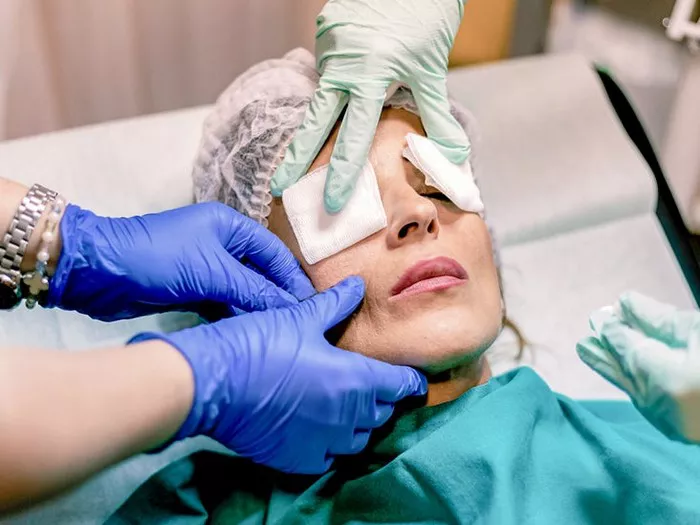Blepharoplasty, or eyelid surgery, is a popular cosmetic procedure aimed at rejuvenating the appearance of the eyes by addressing issues such as sagging eyelids, under-eye bags, and wrinkles. While traditional blepharoplasty techniques have been widely used for many years, advancements in medical technology have introduced a new method known as laser blepharoplasty. In this article, we will explore the concept of laser blepharoplasty, its benefits, and what sets it apart from traditional techniques.
Understanding Laser Blepharoplasty
Laser blepharoplasty is a minimally invasive surgical technique that utilizes laser technology to perform eyelid surgery. It involves the use of a laser to make precise incisions, remove excess skin and fat, and tighten the surrounding tissues. The laser emits a high-energy beam of light that vaporizes or melts the targeted tissues, allowing for greater precision and control during the procedure.
The use of laser technology in blepharoplasty offers several advantages over traditional surgical techniques. The laser’s precision allows for more accurate tissue removal, reduced bleeding, and a shorter recovery period. Additionally, the laser’s thermal energy promotes collagen production, resulting in improved skin texture and elasticity.
Benefits of Laser Blepharoplasty
Laser blepharoplasty offers several benefits for patients seeking eyelid rejuvenation. Here are some of the key advantages of this innovative surgical technique:
Precision: The laser allows for precise incisions, enabling the surgeon to target specific areas with greater accuracy. This precision results in minimal trauma to surrounding tissues and reduces the risk of scarring.
Minimally Invasive: Laser blepharoplasty is considered a minimally invasive procedure as it requires smaller incisions compared to traditional techniques. This results in less post-operative discomfort, a reduced risk of complications, and a shorter recovery time.
Reduced Bleeding: The laser cauterizes blood vessels as it cuts, reducing bleeding during the procedure. This leads to improved visibility for the surgeon and a clearer surgical field.
Faster Healing: Laser energy promotes coagulation and seals blood vessels, which contributes to faster healing and reduced bruising. Patients typically experience less swelling and a shorter recovery period compared to traditional blepharoplasty.
Improved Skin Texture: The thermal energy of the laser stimulates collagen production in the treated areas. This helps improve the overall texture, tone, and elasticity of the skin, resulting in a more youthful and rejuvenated appearance.
Versatility: Laser blepharoplasty can be used to address various eyelid concerns, including excess skin, fat pockets, under-eye bags, and fine lines. The versatility of the laser allows for precise customization of the procedure to meet the individual needs of each patient.
Long-lasting Results: Laser blepharoplasty provides long-lasting results, similar to traditional blepharoplasty techniques. The removal of excess skin and fat, along with the tightening of underlying tissues, helps restore a more youthful and refreshed appearance that can endure for many years.
The Laser Blepharoplasty Procedure
The laser blepharoplasty procedure typically follows these steps:
Consultation and Evaluation: Prior to the surgery, you will have a consultation with a qualified plastic surgeon. They will evaluate your eyelids, discuss your goals, and determine whether laser blepharoplasty is suitable for your specific needs.
Anesthesia: Depending on the extent of the procedure and your preferences, local anesthesia with sedation or general anesthesia may be administered. This ensures your comfort throughout the surgery.
Laser Incisions: The surgeon will make precise incisions using the laser, tailored to your individualized treatment plan. The laser energy simultaneously cuts and seals the tissue, reducing bleeding and promoting faster healing.
Tissue Removal and Tightening: Excess skin and fat are carefully removed, and the underlying muscles and tissues are tightened as needed to achieve the desired aesthetic outcome.
Wound Closure: Once the necessary adjustments are made, the surgeon will close the incisions using fine sutures. The sutures may be removed within a week or two, depending on the healing progress.
Recovery and Follow-up: After the procedure, you will be given specific post-operative instructions to follow. This may include using prescribed eye drops or ointments, avoiding strenuous activities, and attending follow-up appointments to monitor your healing progress.
Is Laser Blepharoplasty Right for You?
Laser blepharoplasty can be an excellent option for individuals seeking eyelid rejuvenation and who desire the benefits of a minimally invasive approach. However, the suitability of the procedure will ultimately depend on your unique circumstances and the recommendation of a qualified plastic surgeon.
During a consultation, your surgeon will evaluate your specific needs, discuss your goals, and determine if laser blepharoplasty is the most appropriate technique for achieving your desired outcome. They will also address any concerns or questions you may have, providing you with all the information you need to make an informed decision.
Conclusion
If you are considering eyelid surgery to rejuvenate your appearance, it’s essential to consult with a board-certified plastic surgeon who specializes in laser blepharoplasty. They will assess your individual needs, discuss the procedure in detail, and provide personalized recommendations based on your goals and anatomy.
Remember that laser blepharoplasty offers the benefits of precision, minimal invasiveness, reduced bleeding, and improved skin texture. By choosing this advanced technique, you can achieve a more youthful and refreshed appearance while benefiting from a shorter recovery time and long-lasting results.


